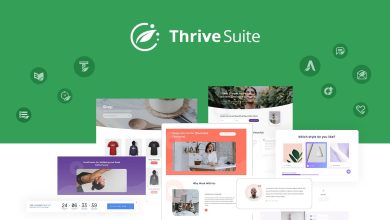I Analyzed 300K Keywords. Here’s What I Learned About AI Overviews
[ad_1]
I analyzed 300K keywords to understand what triggers AI Overviews. The results were predictable in some ways and wholly surprising in others.
For instance, one of my favorite stats (although not the favorite – you’ll have to read on for that ) is that 99.9% of AI Overview SERPs display at least one other SERP feature.
In this study I attempt to nail-down the key differences between AIO SERPs, vs. non-AIO SERPs.
I hope you find it interesting!
| Metric | AIO SERPs | Non-AIO SERPs |
|---|---|---|
| Median Keyword Difficulty | 12 | 33 |
| Median Search Volume | 500 | 29,000 |
| Median Traffic Potential | 2,200 | 18,000 |
| Median CPC | 0.35 | 0.45 |
| Median Keyword Length | 4 | 2 |
| Mobile Traffic Percent | 81% | 77% |
| Desktop Traffic Percent | 19% | 23% |
- AIO keyword Traffic Potential (TP) is 8x smaller than non-AIO SERPs.
- AIO keywords are long-tail, with a phrase length of 4 words vs. 2 words in non-AIO SERPs.
- Keyword Difficulty (KD) is lower in AIO SERPs, with a median score of 12 vs. 33 for non-AIO keywords.
- Content requires just 13 referring domains to rank in an AIO SERP on average.
- Informational intent keywords trigger an AI Overview 99.2% of the time.
- AIOs only have a 10% chance of showing for commercial and transactional keywords.
- 99.9% of AIO SERPs returned at least one other SERP feature, with 3 showing on average.
- AIO keywords trigger 849% more Featured Snippets and 258% more Discussions compared to non-AIO queries.
- On the other hand, AIO SERPs show 96% fewer Sitelinks, 84% fewer Videos, and 75% fewer Knowledge Panels compared to non-AIO SERPs.
Research from SEOClarity shows that AI Overviews source a top 10 ranking page in the SERPs 99.5% of the time.
Kevin Indig takes this research even further, proving that 40% of AIO sources rank beyond the top 10, in positions 11-20.
It stands to reason that the more you know about ranking organically in an AI-topped SERP, the easier it will be to appear in an actual AI Overview.
Based on that logic, I decided to analyze 150K of the most searched keywords that generate an AI Overview, vs. 150K of the most searched keywords without an AI Overview, to find out the key attributes of AIO topped SERPs.
I’ve studied quite a few similar metrics to Flow Agency’s research of 5K HR and Workforce Management AIO Keywords carried out by the awesome Helene Jelenc back in July—which also used Ahrefs—so if you’ve read that study, you’ll be familiar with this data.
Ahrefs now tracks AI Overviews
Ahrefs has also just recently released two powerful new features in Keywords Explorer, which inspired me to do this analysis:
The AI Overview SERP Feature filter, which returns every keyword that generates an AI Overview in the SERPs…
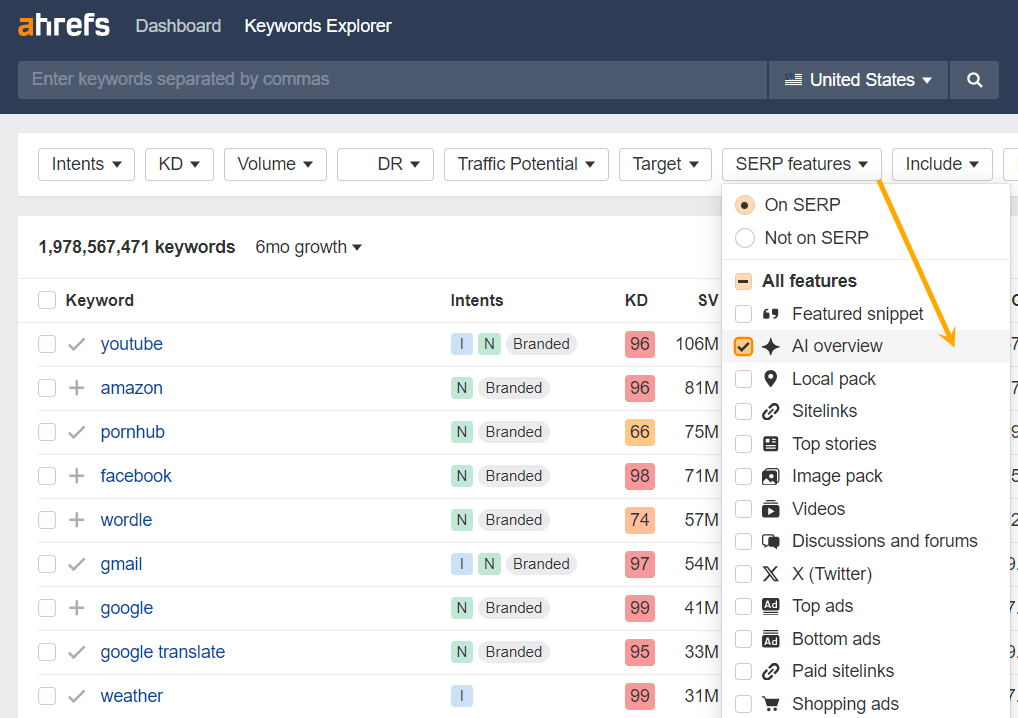
And the Intents filter…
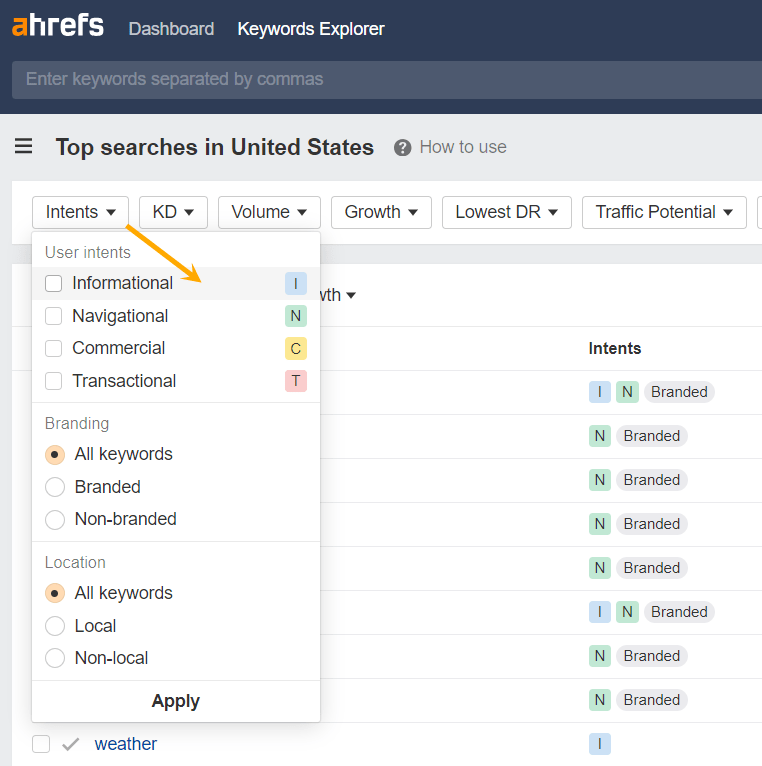

Now, without further ado, here are my 5 top findings from the research:
AI Overviews predominantly appear for low-volume, long-tail keywords.
Even the most popular AIO keywords generate minimal search demand, averaging just 150 searches monthly. In fact, AIO keyword search volumes are 193 times smaller than that of non-AIO keywords (which drive 29K on average).
AIO keywords also generate 8 times less traffic potential—which is essentially the sum of organic traffic earned by the #1 ranking page, from all its many keywords and rankings.
The data shows that AIO queries are long-tail, containing 4 words on (median) average vs. 2 for standard searches, which explains those traffic and volume shortfalls.
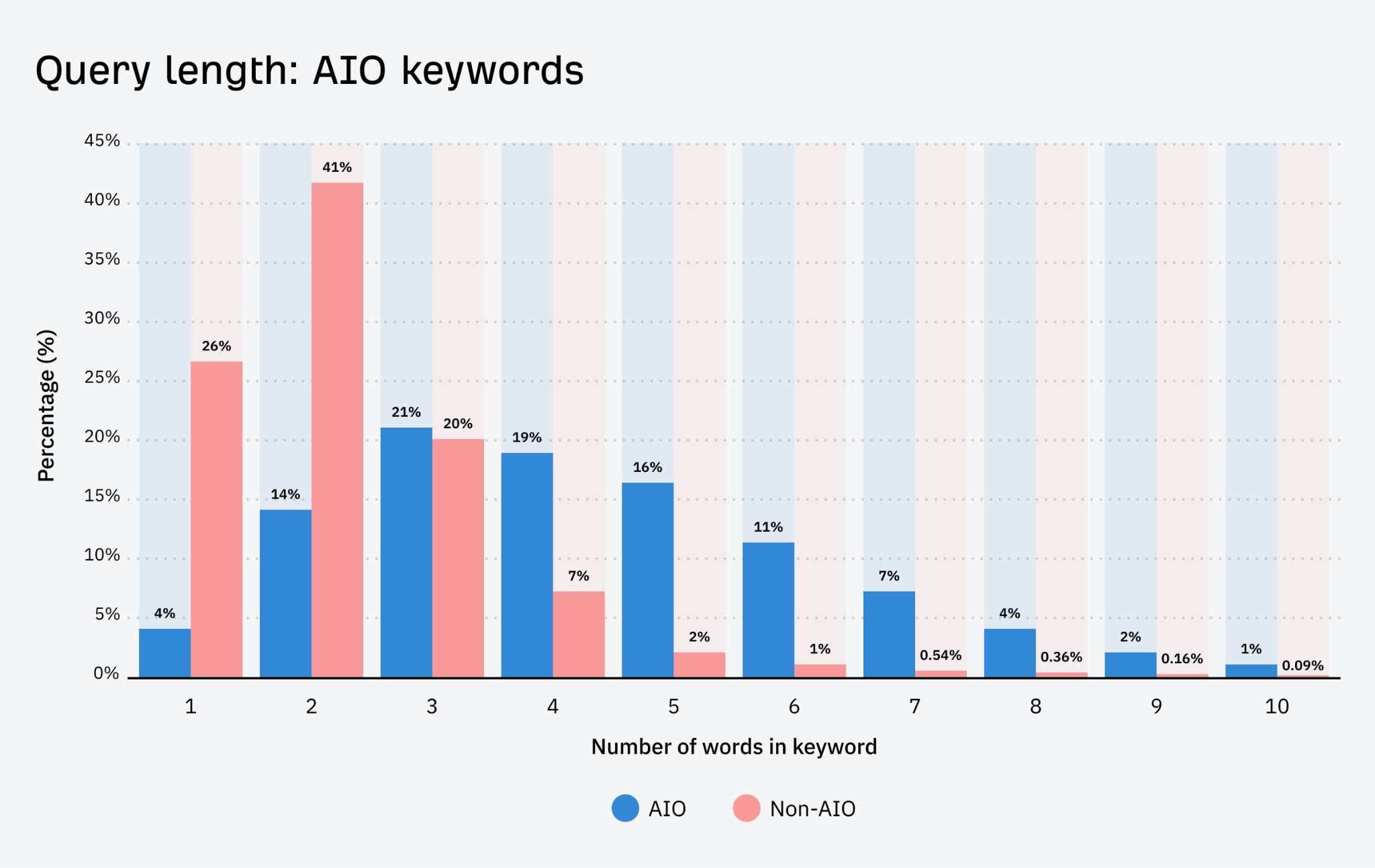

Sidenote.
You’ve probably noticed that the most common AIO phrase length on the chart above is 3—not 4, as I said above. This is because the chart uses the “mode average”, or most common keyword phrase length, in order to see the percentage breakdown. I have used median averages when analyzing standalone stats across the entire dataset, since they’re less affected by extreme values or outliers.
Comparing phrase lengths, you can see that the majority of non-AIO keywords trend towards the left of the chart around the lower numbers, confirming their short-tail nature, while AI Overview keywords peak at 3 words and are more evenly distributed across longer phrase lengths.
AI Overviews are designed to answer user questions, so it makes sense that AIO keywords are more discursive, and longer-tail.
I also noticed that these keywords tended to be question-focused. As a quick example, filtering for the typical question keyword “How” in the AIO dataset returned 20K results, compared with only 55 in the non-AIO dataset.
FYI: Since conducting this research, Ahrefs’ amazing developers have pushed a new preset in Ahrefs’ Keywords Explorer, which allows you to easily zero-in on question keywords.
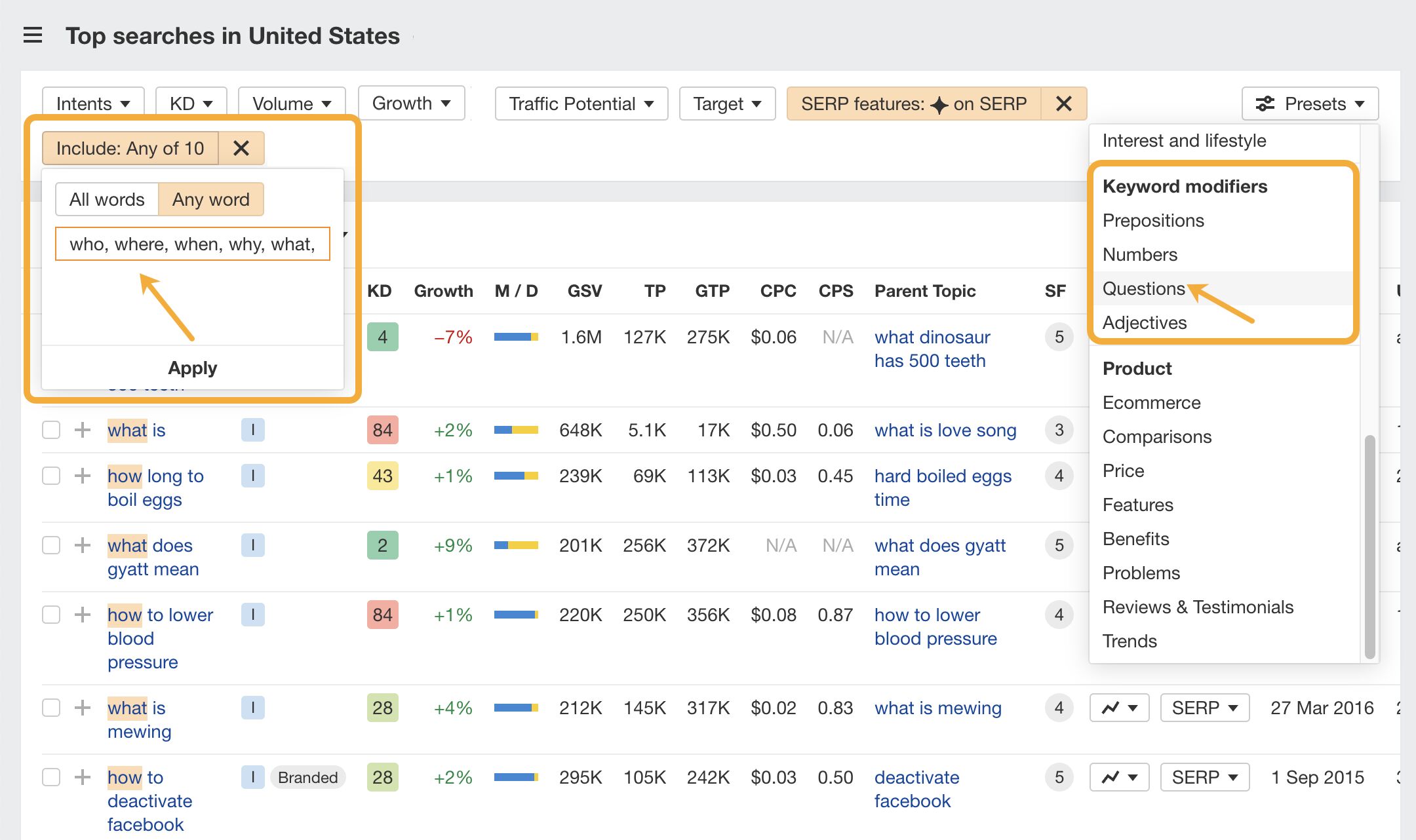

Typically, AIO keywords also displayed clearer intent. Take the eighth most searched keyword in the dataset, “ozempic side effects”, for example. The goal of the searcher is fairly unequivocal.
These aren’t the most groundbreaking of insights—they’re pretty much what I expected to see—but it’s always good to get a theory confirmed with real data.
Tip
AIO keywords don’t always drive lower traffic. Here’s how to find AIO keywords with higher traffic potential.
- Search a broad keyword in Keywords Explorer > Matching Terms report
- Select the AI Overviews in the SERP Feature filter
- Sort Traffic Potential from high to low
- Find high traffic potential AIO keywords
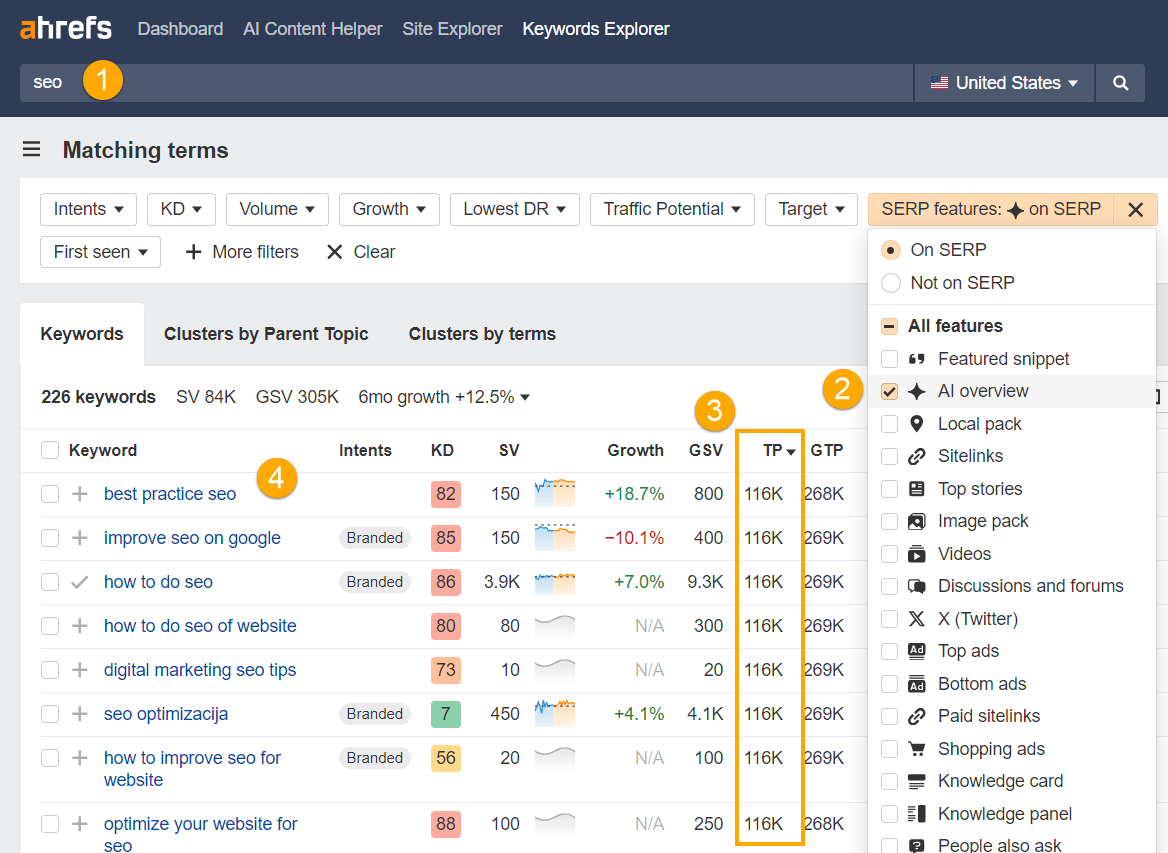

Keyword Difficulty is a metric we devised to help you understand how hard it is to rank for a particular search query, based on the number of referring domains (RDs) earned by the Top 10 organically ranking pages.
From the data, 71% of AI Overview keywords have a Keyword Difficulty score below 30, with the median average being 12—compared with a median average of 33 for non-AI results.
Given that AIO keywords are the longer-tail, lesser searched of the two, this tracks.
Here’s an example keyword from the dataset with a Keyword Difficulty of 12: “Can dogs have cinnamon” (the answer is yes, in small amounts, for anyone that’s wondering!)
To rank in the SERP for many AIO keywords in the study, you would only need a minimum of 13 referring domains, vs. 41 for non-AIO SERPs.
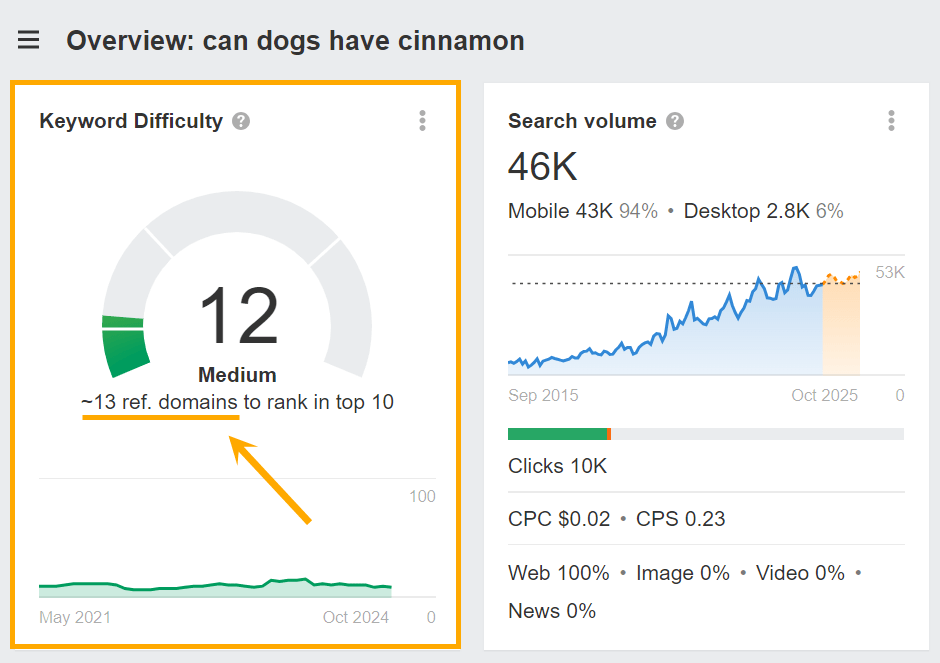

While they drive lower volumes and traffic, AIO topped SERPs require fewer backlinks to enter into.
Tip
Find low difficulty AIO keyword opportunities from your competitors:
- Search your competitors’ domain in Site Explorer > Organic Keywords report
- Switch on the AI Overview SERP Feature filter
- Select “Where target ranks” to see which AI Overviews your competitors own
- Apply a maximum Keyword Difficulty filter of 50
- Find relevant AI Overview generating keywords
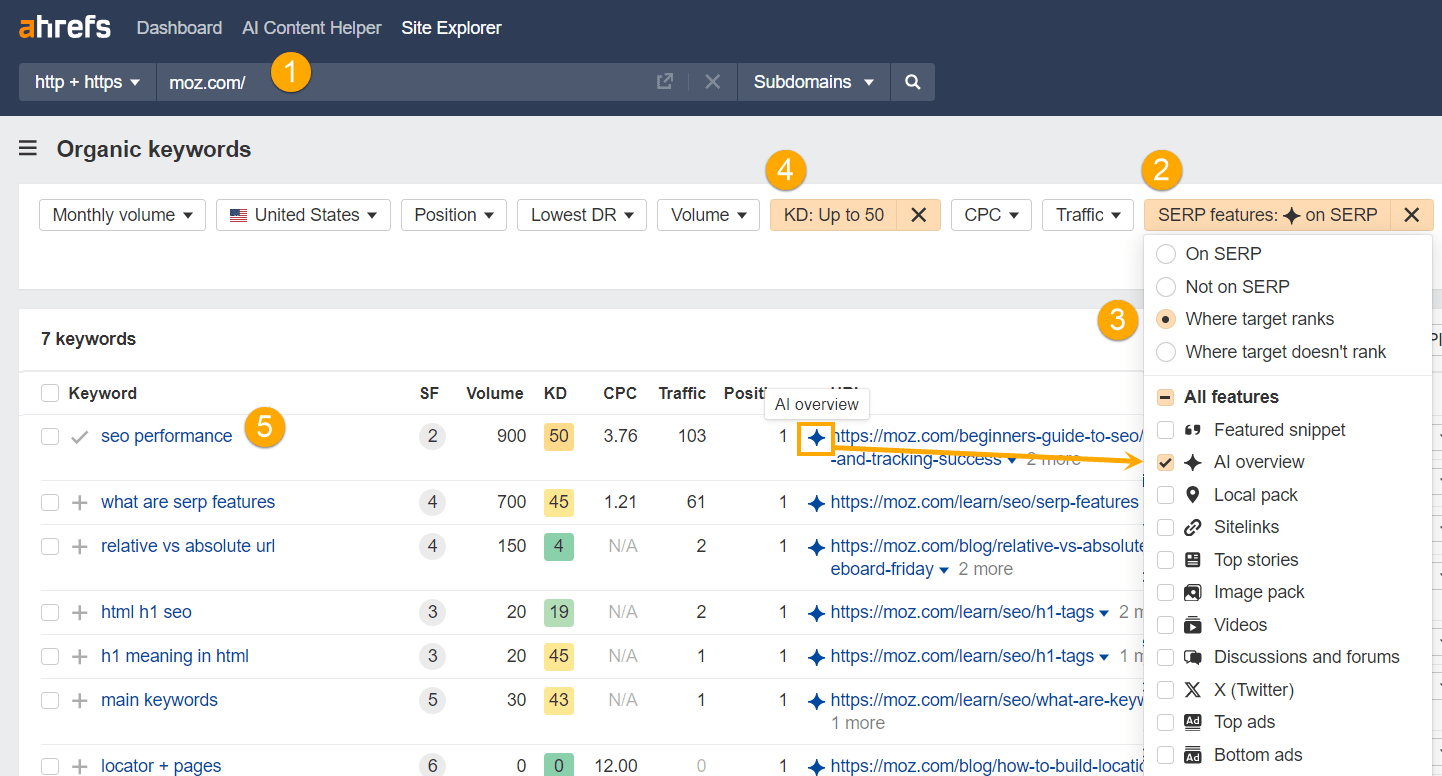

As it stands, 99.2% of all AI Overview keywords are informational.
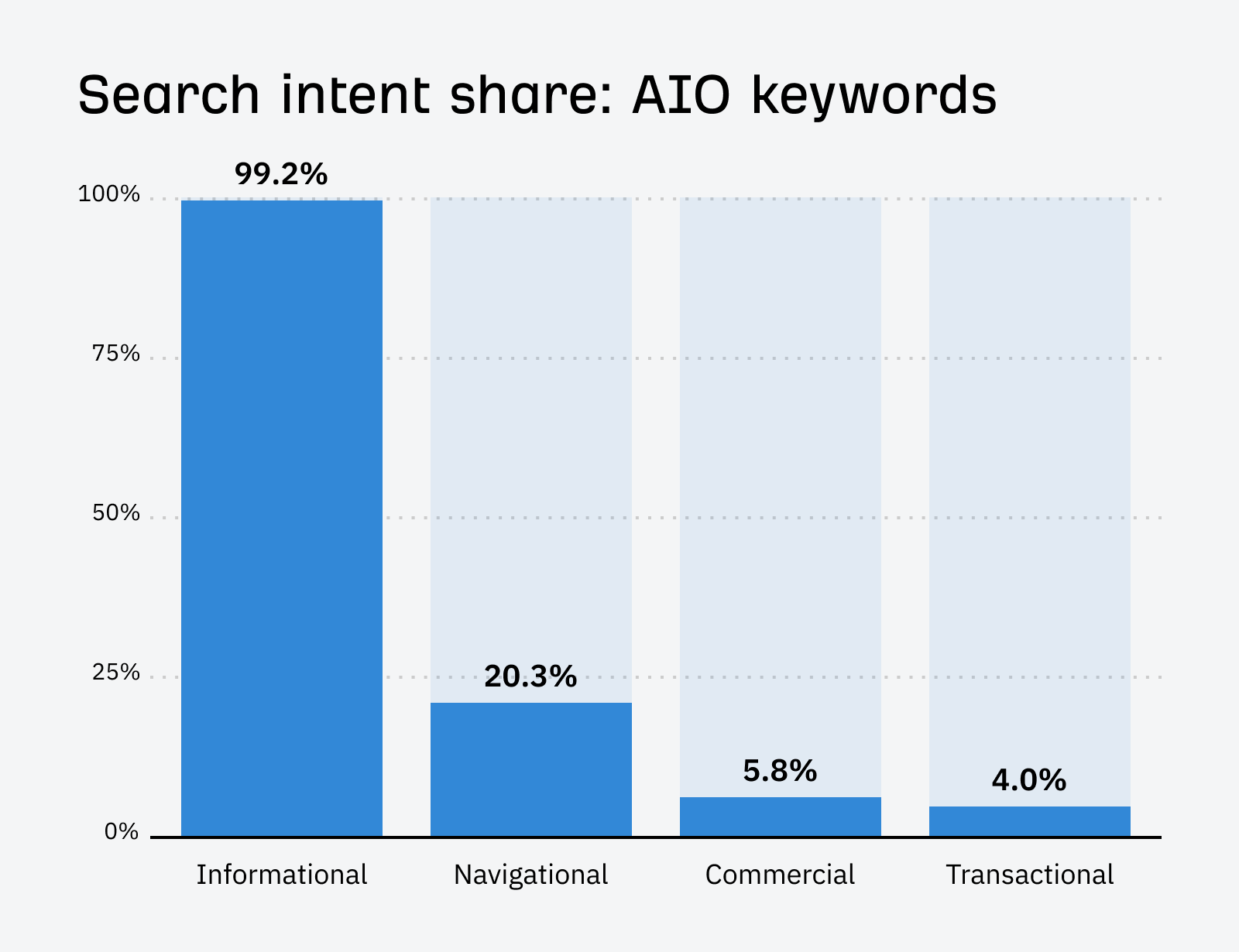

AI Overviews generate when users are looking for details, explanations, or guidance, as opposed to making direct purchases.
Commercial and transactional keywords are harder to come by, making up less than 10% of all AIO SERPs analyzed (5.8% and 4.0% respectively).
But I expect this may increase, what with Google rolling out ads in AI Overviews.
When it comes to non-AIO keywords, search results are still overwhelmingly informational, but other intents appear more frequently vs. AIO SERPs.
For instance, there were double the amount of commercial and transactional keywords in the non-AIO analysis vs. the AIO dataset (20% vs. 10%).
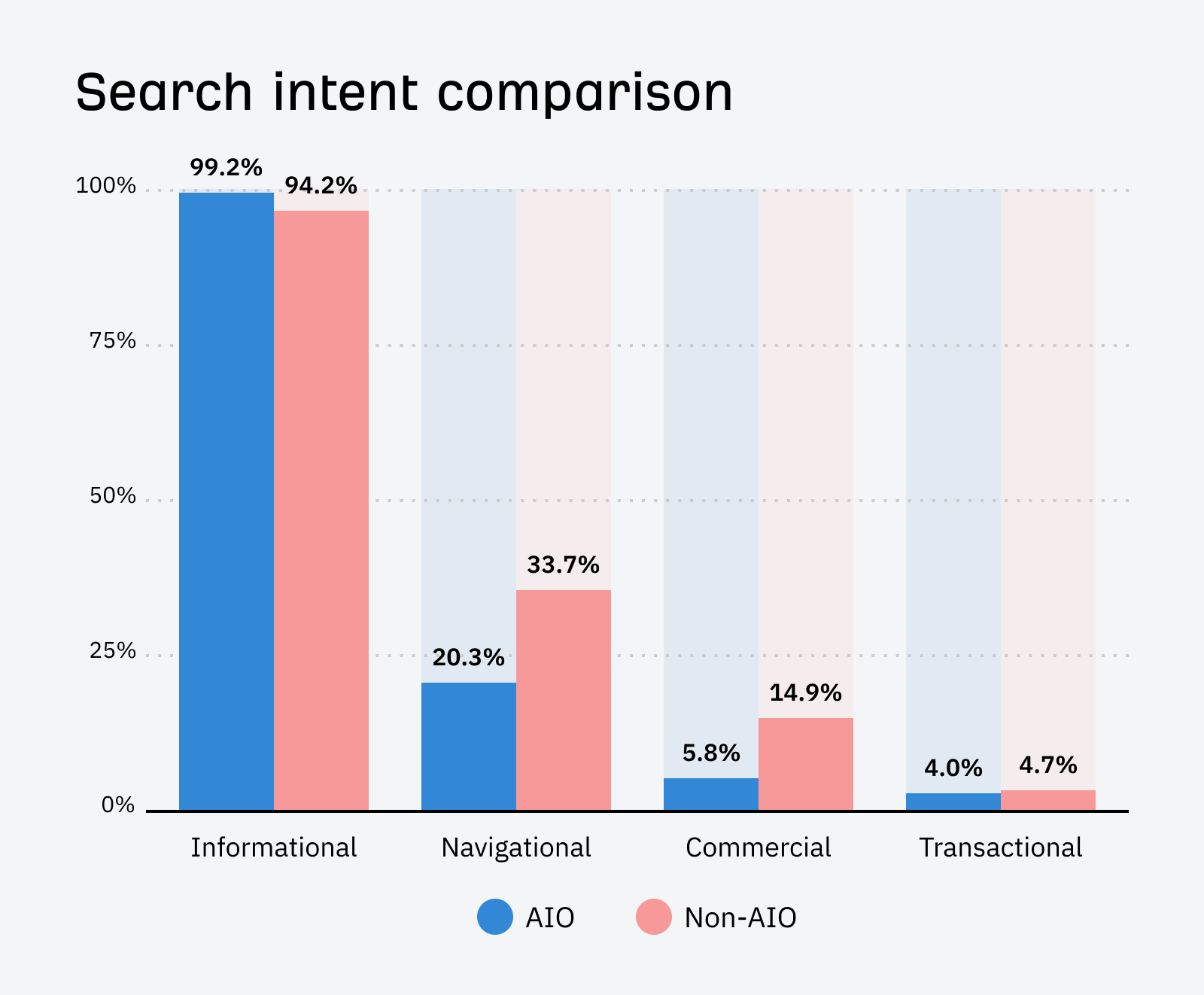

Sidenote.
Bear in mind that the numbers don’t add up to 100% because many keywords display multiple intents.
I was surprised to see transactional queries showing AIO only ~10% of the time, an increase from the 5-7% seen at launch. This will certainly impact SEOs’ strategy for transactional pages. Ranking only in organic search without regard for appearing in AIO will lead to missed opportunities.
Tip
Find informational AIO keywords during your keyword research.
- Search a broad keyword in Keywords Explorer > Matching Terms report
- Set the Intent filter to “Informational”
- Select the AI Overviews in the SERP Feature filter
- Find informational AIO keywords
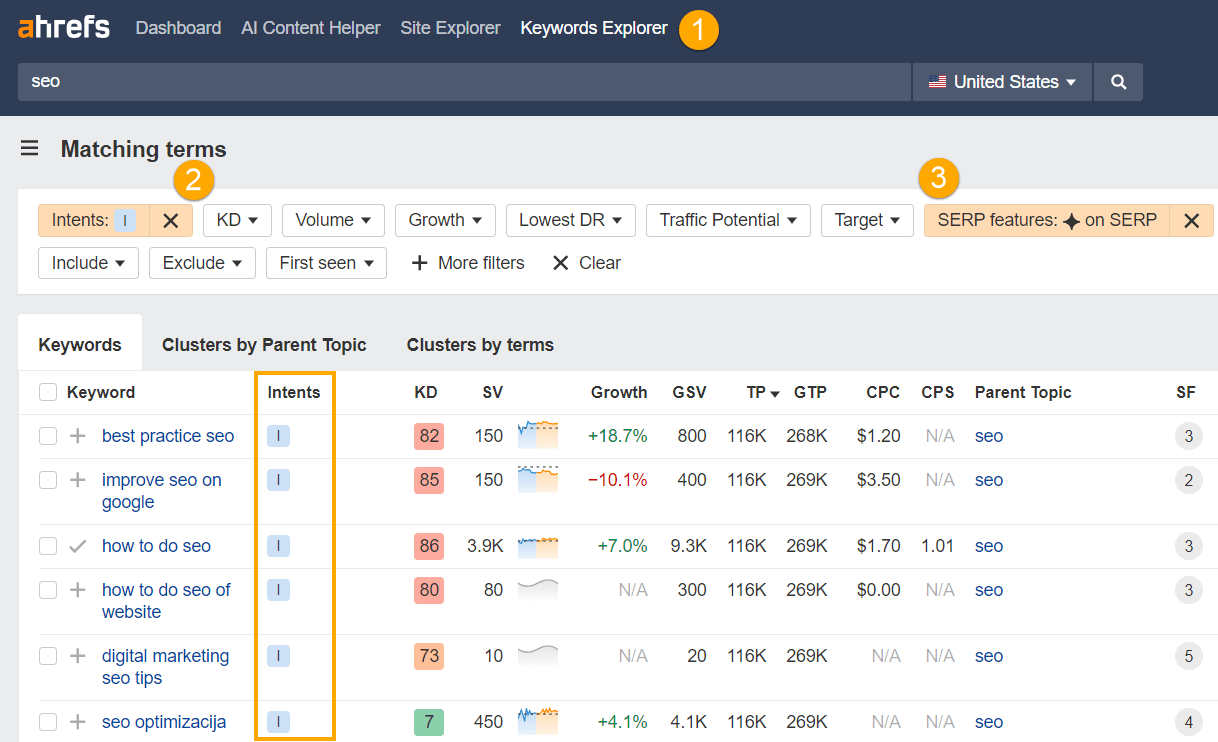

Remember that SEOClarity study? The better visibility you have in organic search results, the more likely you are to win visibility in AI Overviews.
And organic search results don’t just mean classic blue links anymore—that much we all know.
With that in mind, I decided to analyze the prominence of 18 SERP features in AIO search results.
Of the 150K AI Overview SERPs I analyzed, 99.95% returned at least one other SERP Feature.
In fact, each SERP returned 3 on average—ignoring the AI Overview itself.
If you want to own an AI Overview, you should consider optimizing your way into SERP Features.
Specifically, think about infusing your content with Q&As.
The “People Also Ask” feature appeared in 80.92% of all AI Overview queries.
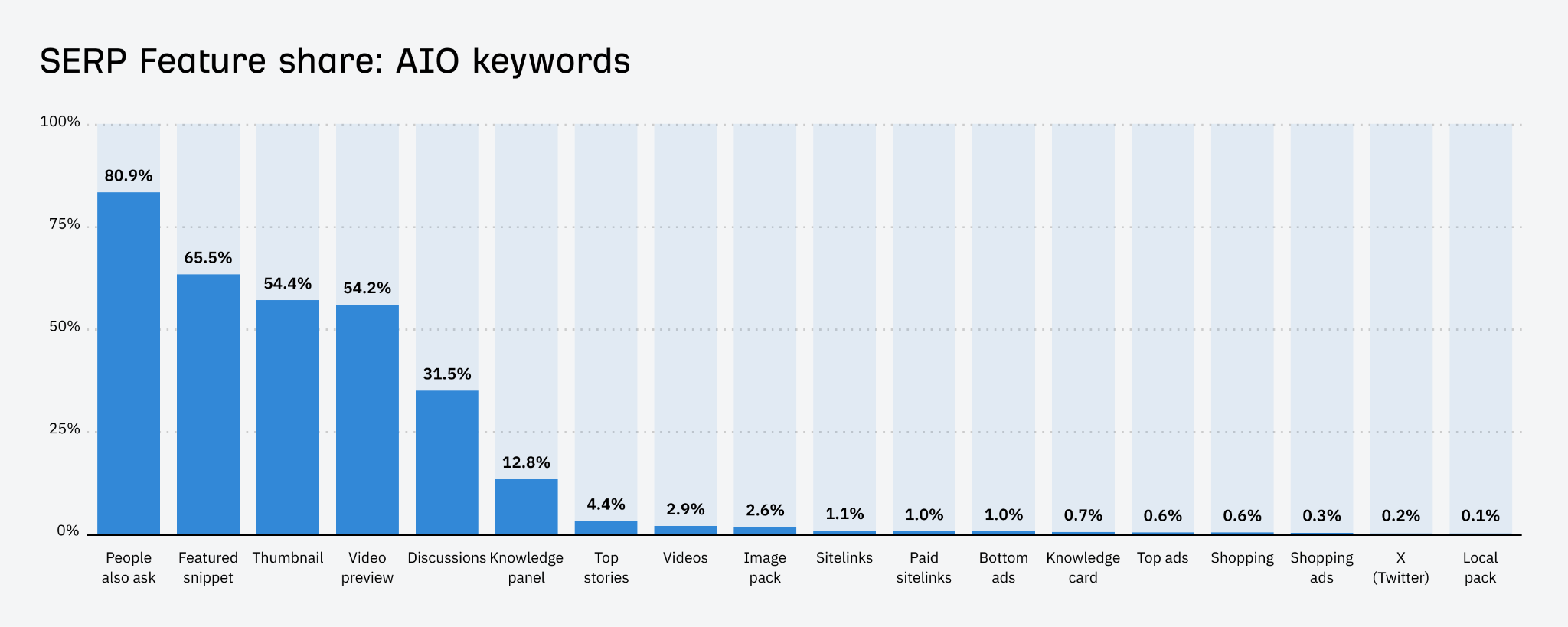

Featured Snippets, Thumbnails, Video Previews, and Discussions were also prominent.
And things got even more interesting when I compared against non-AIO keywords…
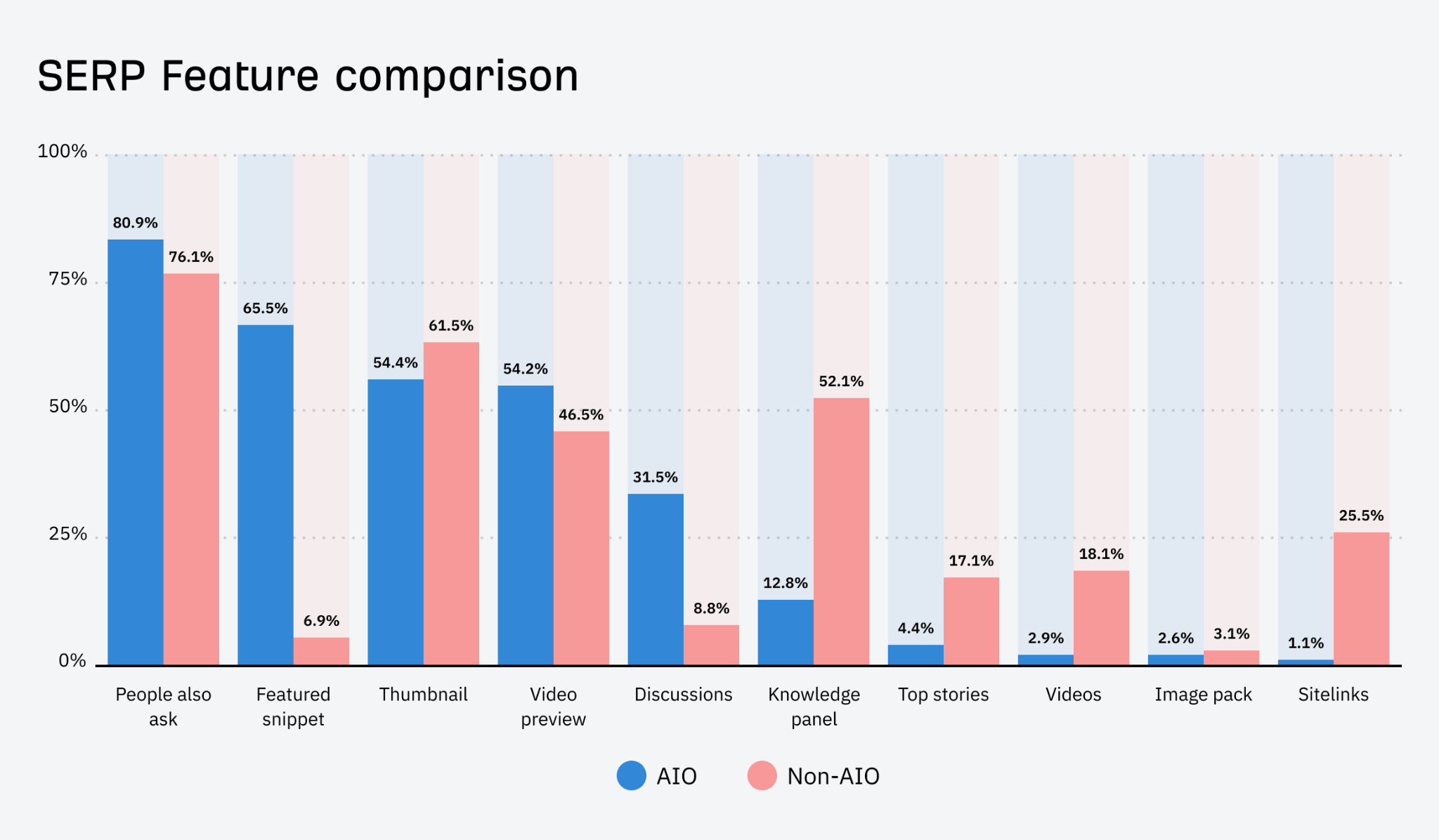

There was only a minor difference in the presence of People Also Ask for AIO and non-AIO keywords, but there were other feature contrasts that leaped out of the data.
Keywords that trigger AIOs also trigger…
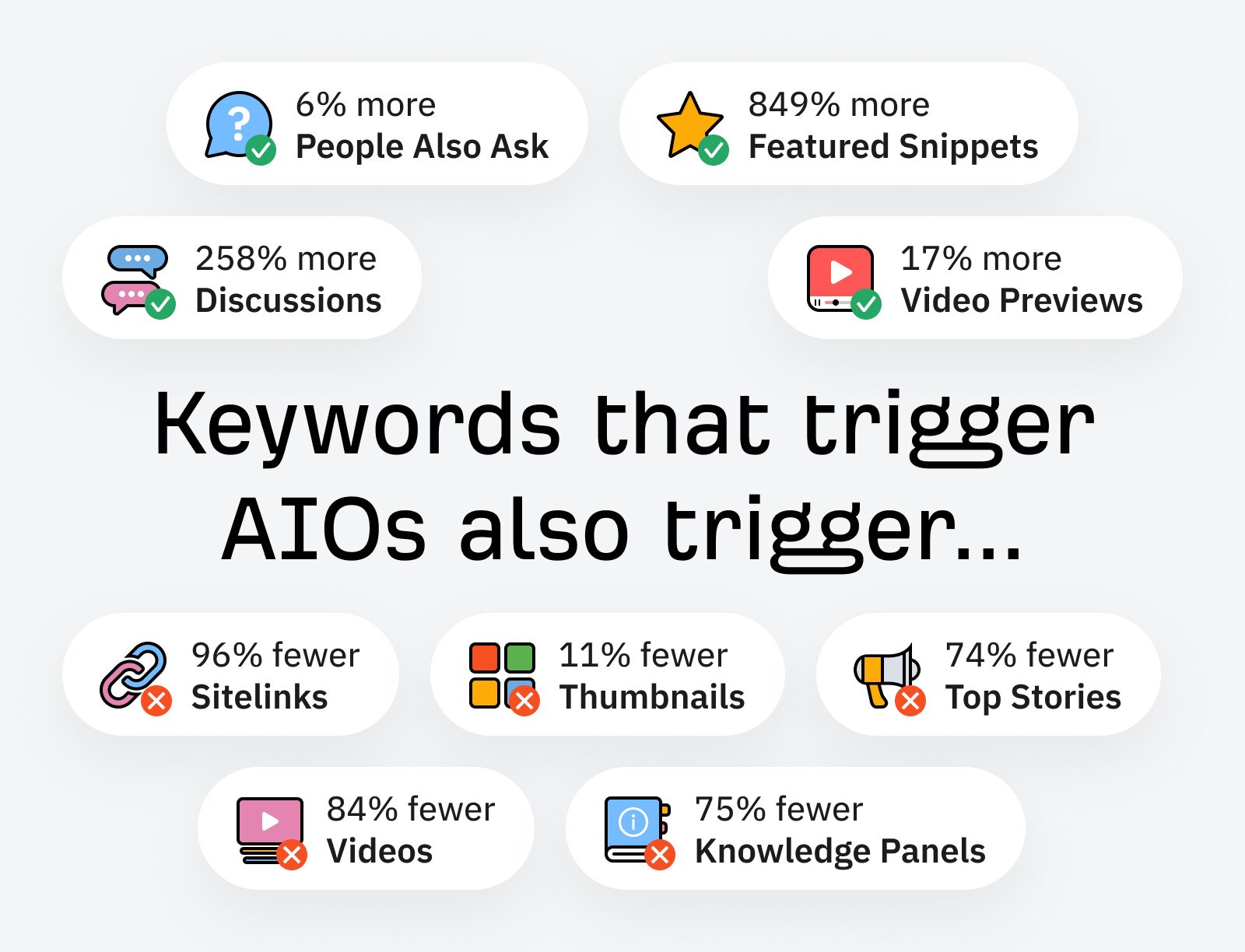

…vs. non-AIO search results.
If you think that AI Overviews are supplanting Featured Snippets, think again.
This feature appears in over half of all queries in the dataset. It’s intrinsically tied to the AIO SERP.
This is what it looks like, for those who are unfamiliar: 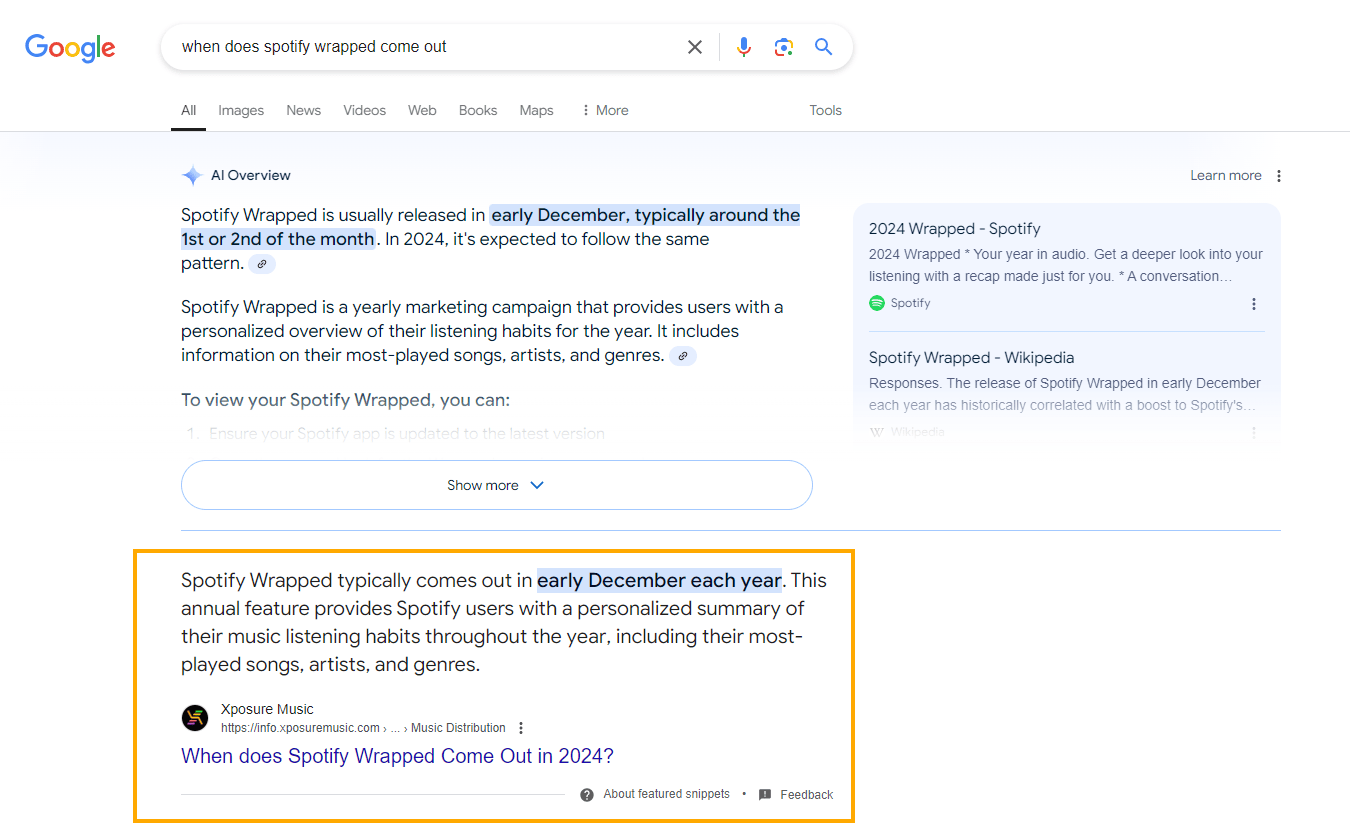

Discussions are also far more prevalent in AIO SERPs at the time of writing. Here’s what they look like on the SERP:
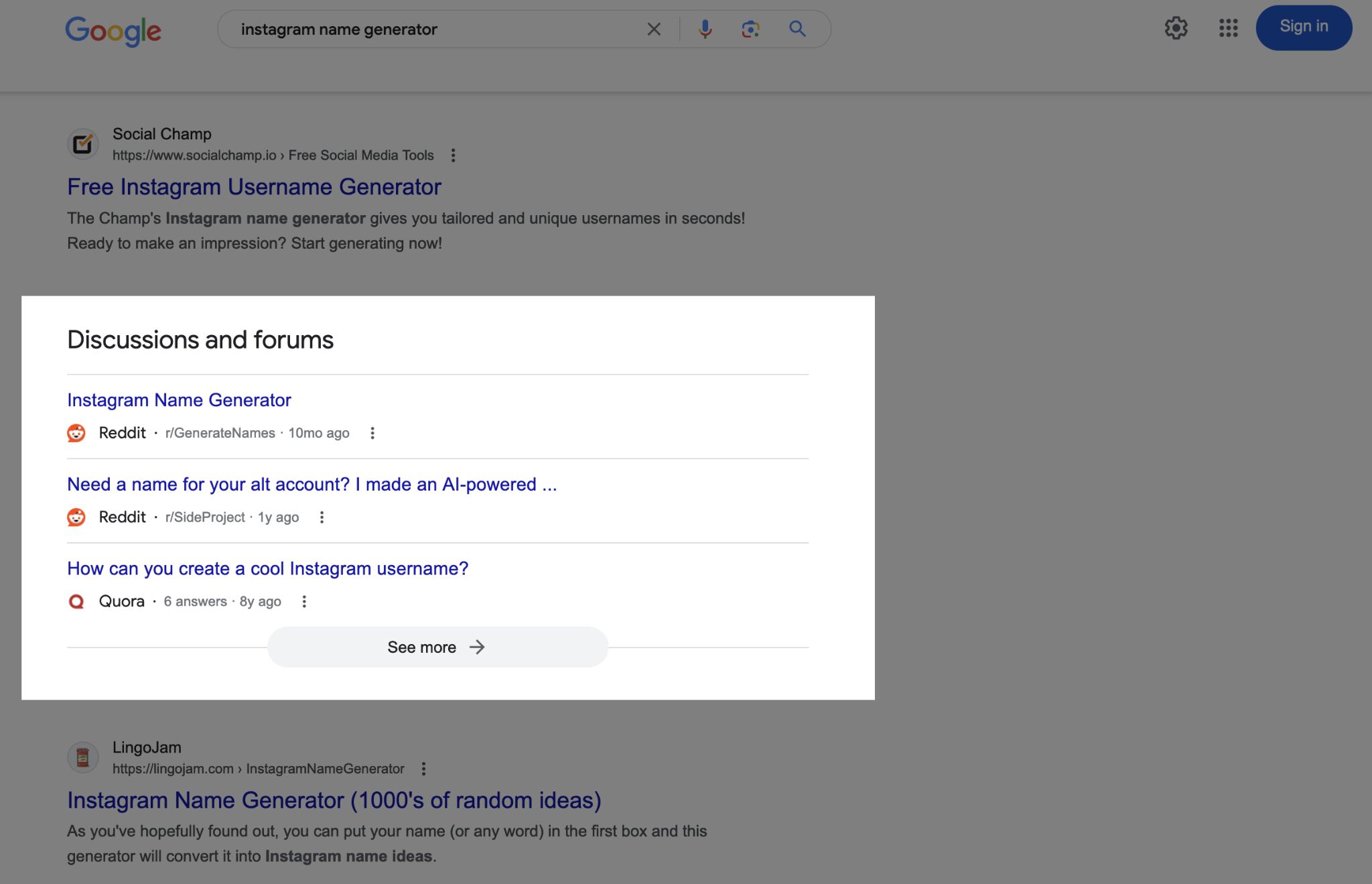

Google has been bumping UGC up the rankings all through 2024, and in a recent interview with Aleyda Solis, Google’s Search Liaison, Danny Sullivan, confirmed they’ll be sticking with this strategy, so it doesn’t surprise me to see far more Discussions present for AIO keywords.
I’ll admit I was surprised to see the Knowledge Panel so low down the AIO chart though, with 76% lower visibility than non-AIO results.
According to Google’s official documentation, it relies on the Knowledge Graph to generate AI Overviews.
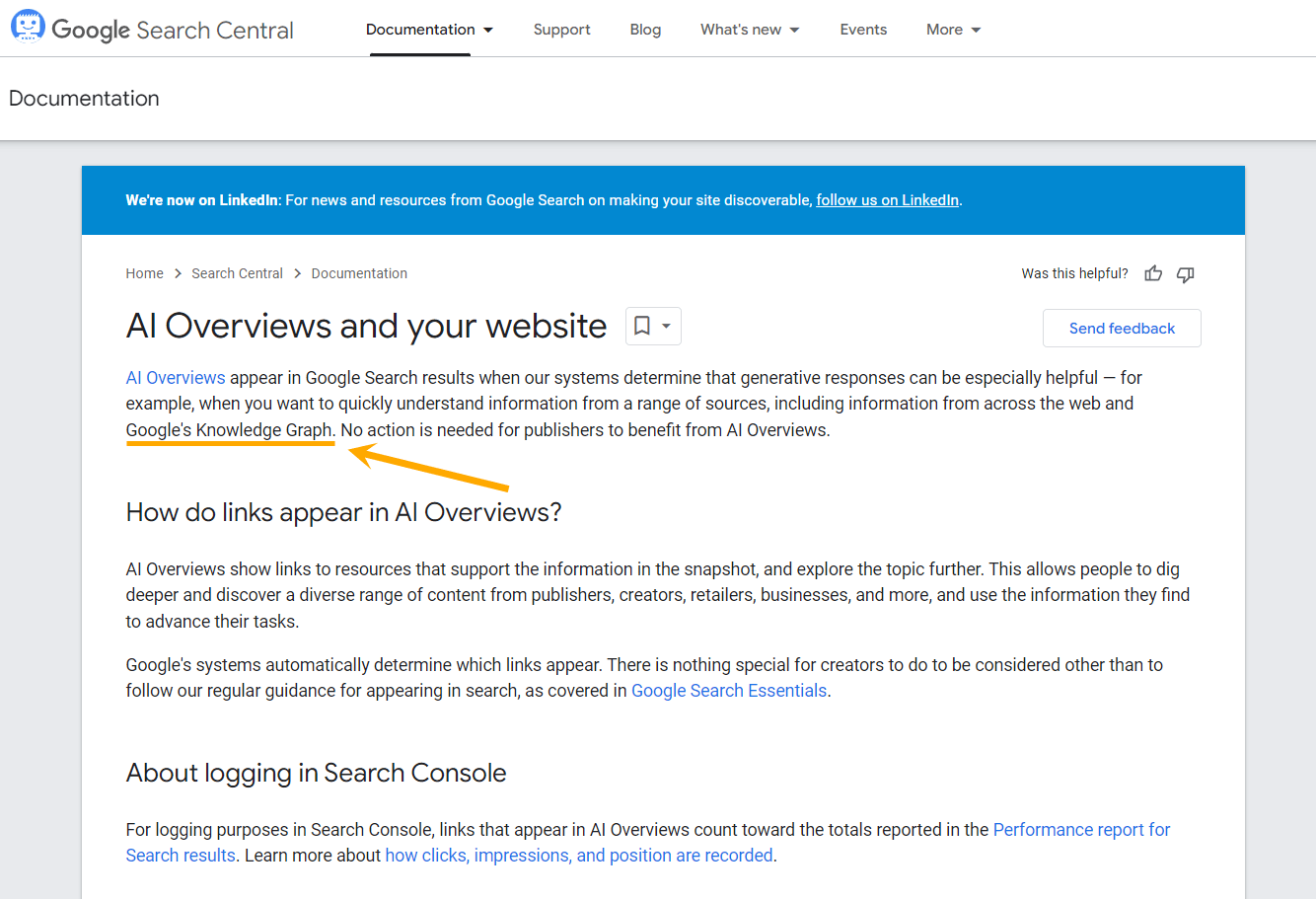

Evidently, it doesn’t need the visual Knowledge Panel to generate AI Overview content, and just grabs information from the Knowledge Graph in the background.
Tip
Align your content with AI Overview generating SERP Features.
- Head to the Questions tab in the Matching Terms report
- Select the Featured Snippet and AI Overview in the SERP Feature filter
- Select People Also Ask in the SERP Feature filter
- Find keywords that generate AIO related SERP Features
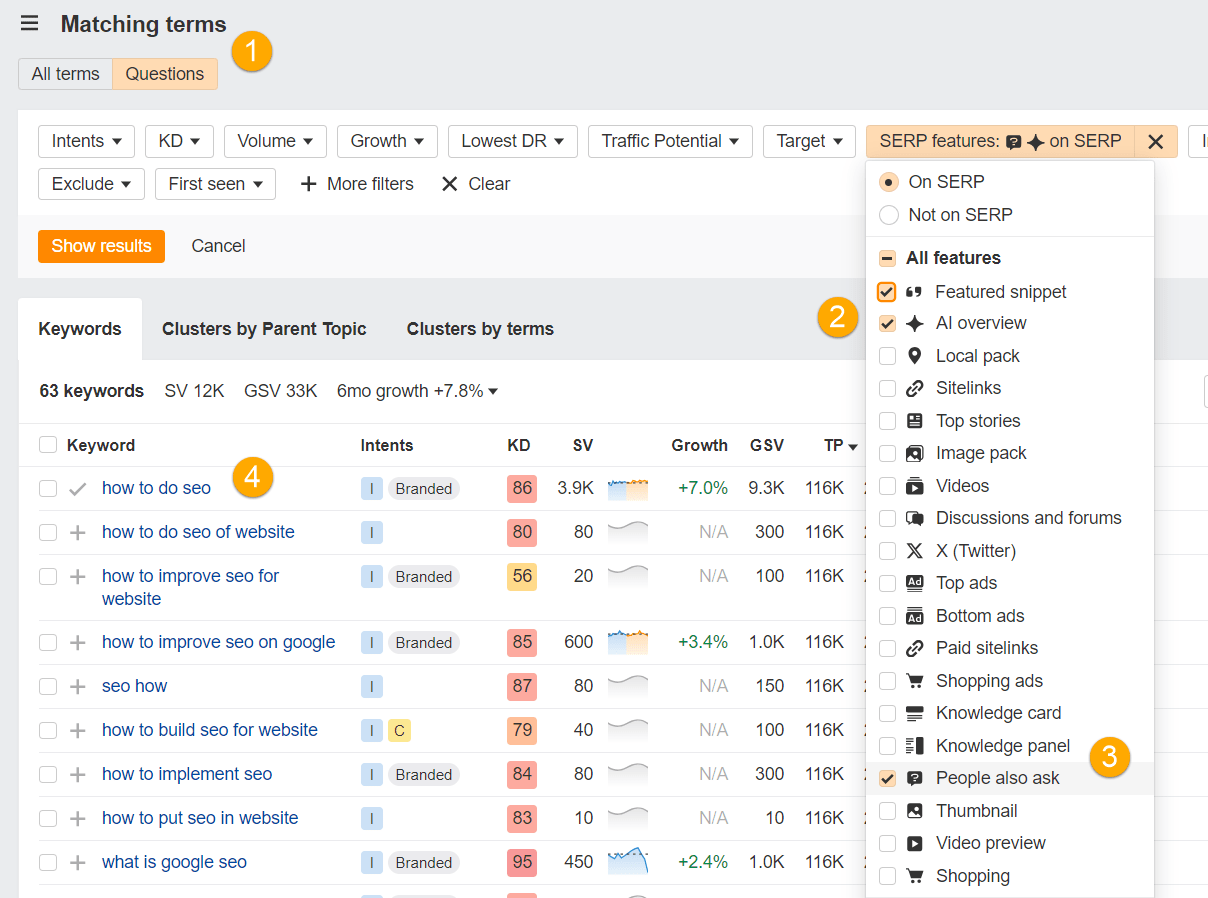

Mobile traffic dominates AI Overview queries, accounting for 81% of traffic, vs. 19% for desktop.
It’s marginally less important to be mobile-optimized for non-AIO queries (77% mobile vs. 23% desktop), but those SERPs are still overwhelmingly mobile-first.
Your content needs to be mobile-ready if you’re hoping to up your visibility in AIO search results.
Tip
Find out the mobile/desktop distribution of your own AIO keywords in Keyword Explorer.
- Head to Keywords Explorer > Matching Terms report
- Switch on the AI Overview filter
- Pay attention to the mobile/desktop distribution column
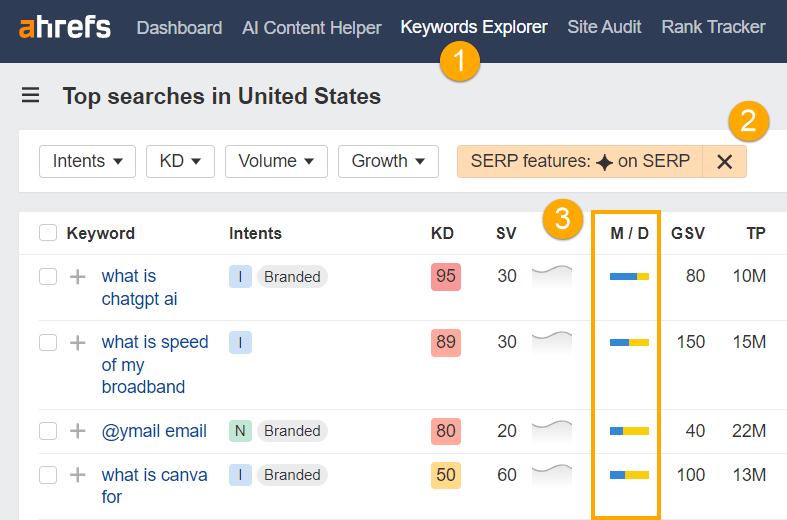

How I compiled this research
I ran an open search in Keywords Explorer, applied Ahrefs’ AI Overview SERP filter, exported the top 150K results, then analyzed the data in Google Sheets with a little help from ChatGPT.
Then I repeated this process for non-AIO generating keywords—the only difference being that I selected the “Not on SERP” filter in Keywords Explorer.
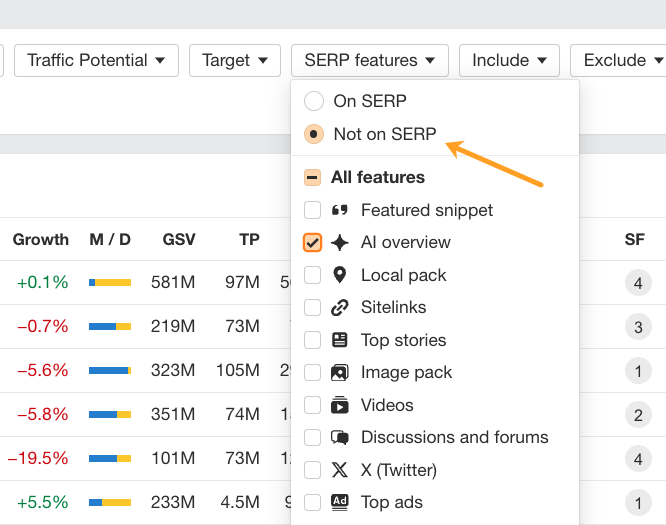

Wrapping up
By focusing on educational content, optimizing for prominent SERP features, and getting your content mobile optimized, you’re generally more likely to boost visibility in AIO SERPs, and maybe even claim the AI Overview by proxy.
Bear in mind this is a fairly broad dataset, given that I’ve analyzed the most searched AIO and non-AIO queries. Metrics will definitely vary across niche keyword categories.
I just did a quick check on 680 SEO/Marketing keywords, for example, and AIO keywords are overwhelmingly desktop driven (72% for desktop vs. 28% for mobile), meaning mobile optimization won’t be as crucial if you work in SaaS.
I wholly encourage you to do your own analyses in Ahrefs for your industry and/or the keywords you care about.
Since I conducted this study, Ahrefs’ Keywords Explorer has discovered even more AI Overview based keywords. We’re working on collecting more data, including the presence of links and domains within the AIO, so keep your eyes peeled for that.
If you have any questions about this research, feel free to drop me a message on LinkedIn. My inbox is always open :]
[ad_2]
منبع:ahrefs



